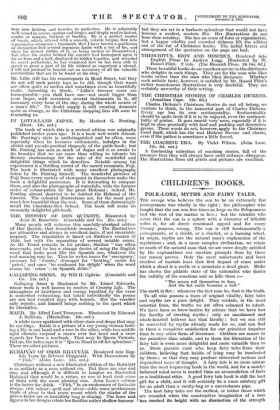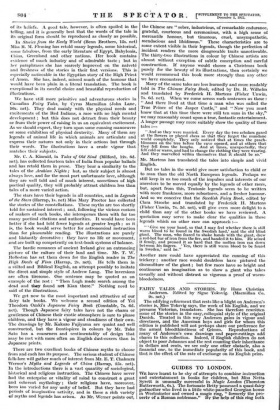CHILDREN'S BOOKS.
FOLK-LORE, MYTHS AND FAIRY TALES.
THE savage who believes the sun to be an extremely fine pomegranate was wholly in the right ; the philosopher who taught that the sun was five times as large as the Peloponnese had the root of the matter in him ; but the scientist who avers that the sun is a sphere with a diameter of 870,000 miles is, for all direct emotional appeal and for every literary purpose, wrong. The sun is still fundamentally a pomegranate, or a shield, or a chariot, or a burning wheel. In origin, myths are the natural man's explanation of the mysterious ; and, in a more complex civilization, we retain so much of the natural man that we are more deeply satisfied by the explanations our emotion prompts than by those our reason proves. Only the most unfortunate and least creative of mortals loses that first impact of sense under which a cloud is a castle or a mountain a dead giant. Blake has shown the pitiable state of the rationalist who denies the validity of his emotions and so kills them :— "The senses roll themselves in fear,
And the flat earth becomes a ball."
The earth is fiat: whatever the fact may be, that is the truth.
To all who possess a trace of original vitality, fairy tales and myths are a pure delight. They contain, in the most essential form, the truths we are often ashamed to admit. We have been so brow-beaten by science that we have lost the faculty of creating myths ; only an unashamed and whole-hearted believer has that faculty ; but we can still be converted by myths already made for us, and can find in them a completer satisfaction for our primitive impulses than in any other form of literature. Children are nearer to the primitive than adults, and to them the liberation of the fairy tale is even more delightful and more valuable than to us. Stern parents exist who keep fairy tales from their children, believing that habits of lying may be inculcated by them ; or that they may produce chimerical notions and impractical ways of thought. A fairy tale is no more untrue than the most improving book in the world, and for a sanely- balanced mind more is needed than an accumulation of facts or a traditional ethic. A good fairy tale book is still the best gift for a child, and it will certainly be a more salutary girl t for an adult than a vanity-bag or a meerschaum pipe.
The best fairy tales are the earliest, or rather those which are recorded when the constructive imagination of a race has reached its height with ao diminution of the strength of its Mids. A good tale, however, is often spoiled in the telling, and it is generally best that the words of the tale in
its original form should be reproduced as closely as possible.
In Stories from the Early World (Benn Brothers, 155. net) Miss R. M. Fleming has retold many legends, some historical, some fabulous, from the early literature of Egypt, Babylonia, China, Greenland and other nations. Her book contains evidence of much industry and of admirable taste ; but in her paraphrases she has scarcely improved on the naiveté and freshness of the stories in their first versions. This is especially noticeable in the Egyptian story of the High Priest of Amen. She has, indeed, missed much of the humour that would have been plain in a literal translation. The book is exceptional in its careful choice and beautiful reproduction of illustrations.
We have still more primitive and adventurous stories in Canadian Fairy Tales, by Cyrus Macmillan (John Lane, 16s. net). They deal mainly with the physical needs and excitements of the Red Indians, a race with no high mental development ; but this does not detract from their beauty or from their power of raising in us an equivalent excitement. As we should expect, they turn upon some cunning manoeuvre or some exhibition of physical dexterity. Many of them are legends of animal life in which animals are articulate and express their natures not only in their actions but through their words. The illustrations have a crude vigour that matches their subjects.
Mr. C. A. Kincaid, in Tales of Old Sind (Milford, 12s. 6d. net), has collected fourteen tales of India from popular ballads and has retold them in prose. They bear a similarity to the tales of the Arabian N ights ; but, as their subject is almost always love, and for the most part unfortunate love, although they are well told and of much interest, sometimes of high poetical quality, they will probably attract children less than tales of a more varied action.
The stars have their legends in all countries, and in Legends of the Stars (Harrap, is. net) Miss Mary Proctor has collected the stories of the constellations. These myths are too shortly told for sustained interest ; and, following the vicious custom of makers of such books, she intersperses them with far too many poetical citations and authorities. It would have been better if she had told fewer legends at greater length ; as it is, the book would serve better for astronomical instruction than for pleasurable reading. The illustrations are purely and blatantly decorative : they have no life or movement, and are built up competently on text-book systems of balance.
The bardic romances of ancient Ireland give an entrancing picture of the culture of their land and time. Mr. T. W. Rolleston has set them down for the English reader in The High Deeds of Finn (Harrap, 2s. net). He tells them in a stilted and Biblical English, an attempt possibly to imitate the direct and simple style of Andrew Lang. The inversiOns are often tiresome. One sentence may be quoted as . an example of the rest : "Then Lugh made search among the dead and they found not Iiian there." Nothing need be said of the illustrations.
We get now to the most important and attractive of our fairy tale books. We welcome a second edition of Yei Theodora Ozaki's Japanese Fairy Book (Constable, 7s. (Id. net). Though Japanese fairy tales have not the charm or gentleness of Chinese their exotic atmosphere is sure to please children, and they have a vigour and steadiness of their own. The drawings by Mr. Kakuzo Fujiyama are quaint and well constructed, but the frontispiece in colours by Mr. Take Sato has a coarseness and sentimentality of design that may be met with more often on English dust-covers than in Japanese prints.
There are two excellent books of Chinese myths to choose from and each has its purpose. The serious student of Chinese folk-lore will gather much of interest from Mr. E. T. Chalmers Werner's Myths and Legends of China (Harrap, 25s. net). In the introductions there is a vast quantity of sociological, historical and religious instruction. The Chinese have never had the enterprise or vitality of mind to construct a great and coherent mythology ; their religions have, moreover, been too varied for any unity of belief. But they have had periods of imaginative activity, and in these a rich variety of myths and legends has arisen. As Mr. Werner points out,
the Chinese are "sober, industrious, of remarkable endurance, grateful, courteous and ceremonious, with a high sense of mercantile honour, but timorous, cruel, unsympathetic, mendacious and libidinous." These characteristics are to some extent visible in their legends, though the perfection Of incident renders the more disagreeable traits unnoticeable. The thirty-two illustrations in colour by Chinese artists are almost without exception of subtle conception and careful construction. If anyone would choose a Christmas book purely for the beauty of its illustrations, then certainly we would recommend this book more strongly than any other we have encountered.
Many of the same tales are less learnedly and more readably told in The Chinese Fairy Book, edited by Dr. R. Wilhelm and translated by Frederick H. Martens (Fisher Unwin, 7s. 6d. net). When we come across such sentences as these : "And there lived at that time a man who was called the True Prince of the Jasper Castle," and "Now you must know that at this time there were still ten suns in the sky,t' we may reasonably count upon a true, fantastic entertainment.
A longer passage may more suitably show the quality of these tales :—
"And so they were married. Every day the two scholars gazed at the flowers or played chess so that they forgot the mundane world completely. They only noticed that at times the peach- blossoms on the tree before the cave opened, and at others that they fell from the boughs. And at times, unexpectedly, they felt cold or warm, and had to change the clothing they were wearing. And they marvelled within themselves that it should be so.'
Mr. Martens has translated the tales into simple and vivid English.
But no tales in the world give more satisfaction to child or to man than the old North European legends. Perhaps we still keep in us too much of the impulses and interests of our ancestors to be moved equally by the legends of other races, but, apart from this, Teutonic legends seem to be written with more frankness, more robustness, and a fresher humour.
And so we conceive that the Swedish Fairy Book, edited by Clara Stroebe and translated by Frederick H. Martens (Fisher Unwin, 7s. 5d. net), will give even more delight to a child than any of the other books we have reviewed. A quotation may serve to make clear the qualities in these legends which no other race can approach :—
" Give me your hand, so that I may feel whether there is still warm blood to be found in the Swedish land,' said the old blind giant. The man, who feared to shake hands with the giant, drew a red-hot bar of iron from the fire, and handed it to him. He seized it firmly, and pressed it so hard that the molten iron ran down between his fingers. 'Yes, there is still warm blood to be found in Sweden,' said he."
Another race could have appreciated the cunning • of this trickery ; another race would doubtless have pictured the discomfiture of the giant ; but few races have so bright and continuous an imagination as to show a giant who takes
casually and without distrust so vigorous a proof of warm- bloodedness.







































































 Previous page
Previous page